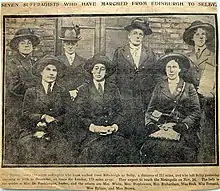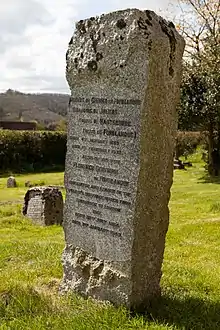Florence Gertrude de Fonblanque
Florence Gertrude de Fonblanque born Florence Gertrude Sparagnapane (22 July 1864 – 2 December 1949) was a United Kingdom suffragist. She was the "Originator and leader of the women's suffrage march from Edinburgh to London 1912".
Florence de Fonblanque | |
|---|---|
.jpg.webp) from a 1916 newspaper | |
| Born | Florence Gertrude Sparagnapane 22 July 1864 |
| Died | 2 December 1949 |
| Nationality | British |
| Known for | organising the "Brown Women" to march from Edinburgh to London |
| Spouse(s) | Robert Edgar De Grenier de Fonblanque |
Life
Fonblanque was born in London to a family who owned the Sparagnapane Christmas cracker and confectionery business. Her mother was Aurelia Williams and her father was Gaudente Sparagnapane. She was taught in Brussels and at Brighton and like her elder sister, Maud, she became an actress. She married a fellow actor, Robert Edgar De Grenier de Fonblanque, when she claimed to be 21 but she was actually 26. In time Robert was given the titles marquess of Juliers, comte de Hautserre, and comte de Fonblanque.[1]
Like her sister she took an interest in women's suffrage. In 1906 she was living in Duncton near Chichester and over the next few years she joined a number of organisations agitating for women to have the vote. In 1912 she was a member of the Conservative and Unionist Women's Franchise Association.[1]
The March

Fonblanque decided to mount a march from Edinburgh to London to draw attention to the women's suffrage cause. She initially thought that walking to Edinburgh would be a good idea but it was decided to march from Edinburgh so that the march could end its publicity in London.[1] Only six women including Agnes Brown[2] and Sarah Benett who was the Treasurer of the Women's Freedom League set off on 21 October 1912.[3] Her sister and Ruth Cavendish Bentinck helped with the organisation.[4] As they and Fonblanque traveled from Scotland to London they gathered signatures on a petition and coverage in the newspapers.[5] Fonblanque ensure that they were dressed in brown with rosettes and bright green cockades[6] and they were known as the "Brown Women". They followed the route of the A1 and they were joined by dignitaries along the way. On one day near Berwick they walked over 30 miles before the now seven marchers were welcomed by the local member of parliament. Their numbers swelled slowly - when they passed through Grantham in November there were twelve walkers including Fonblanque.[3]

Finally they got to London on 16 November where Fonblanque's horse and cart were sent back to Scotland. They went by tube to Trafalgar Square where the walkers entered to music.[7] Her sister Maud Arncliffe Sennett had assisted the march by organising a reception for the marchers when they arrived.[1] Sennett was assisted with the welcome by the National Political League started by Mary Adelaide Broadhurst and Margaret Milne Farquharson. Sennett takes credit for the walk in one source.[8]
Further hikes happened in the U.K. The month after the Edinburgh to London march Rosalie Gardiner Jones had organized the first American Suffrage Hike which left from The Bronx to Albany, New York.[9]
There were reports that she and Ruth Cavendish Bentinck had founded an organisation of non aligned suffragists in 1913. The Qui Vive Corps would wear the brown, green and white uniform described above. It was intended that these would attend any suffrage inspired event.[10] The Qui Vive Corps were involved in campaigning for the Labour Party in Derbyshire and Staffordshire because they objected to the Liberal Party's policy which was against women getting the vote.[4]
Death and legacy
Fonblanque died at her home in Duncton in 1949. She was buried in the churchyard of Holy Trinity Anglican church and she had "Originator and leader of the women's suffrage march from Edinburgh to London 1912" carved on her gravestone at her request.[1]
References
- Elizabeth Crawford, ‘Fonblanque, Florence Gertrude de (1864–1949)’, Oxford Dictionary of National Biography, Oxford University Press, 2004 accessed 17 November 2017
- Eleanor Gordon, ‘Brown, Agnes Henderson (1866–1943)’, Oxford Dictionary of National Biography, Oxford University Press, 2004; online edn, May 2007 accessed 18 November 2017
- "Women on the march in Grantham". Grantham Matters. 25 September 2017. Retrieved 18 November 2017.
- Archives, The National. "The Discovery Service". discovery.nationalarchives.gov.uk. Retrieved 2017-11-25.
- "Northern Men and Votes for Women | History Today". www.historytoday.com. Retrieved 4 November 2017.
- Elizabeth Crawford (2 September 2003). The Women's Suffrage Movement: A Reference Guide 1866-1928. Routledge. pp. 479–. ISBN 1-135-43401-8.
- "Friends of Berwick Museum" (PDF). Friends of Berwick Museum. November 2012. Retrieved 18 November 2017.
- Crawford, Elizabeth (2003-09-02). The Women's Suffrage Movement: A Reference Guide 1866-1928. Routledge. p. 435. ISBN 978-1-135-43402-1.
- "Gen. Jones's Hike Starts. Her Suffragist Army Will Carry a Petition tO Albany" (PDF). New York Times. 2 January 1914. Retrieved 14 August 2009.
'Gen.' Rosalie Jones and her suffragist army started a 'hike' to Albany yesterday to take a petition to the legislature asking for women watchers at the polls when the question of votes for women is voted upon in 1915. The march began at Broadway and 242d Street at 9 o'clock in the morning. ...
- David Doughan, ‘Bentinck, Ruth Mary Cavendish- (1867–1953)’, Oxford Dictionary of National Biography, Oxford University Press, 2004; online edn, May 2006 accessed 25 November 2017